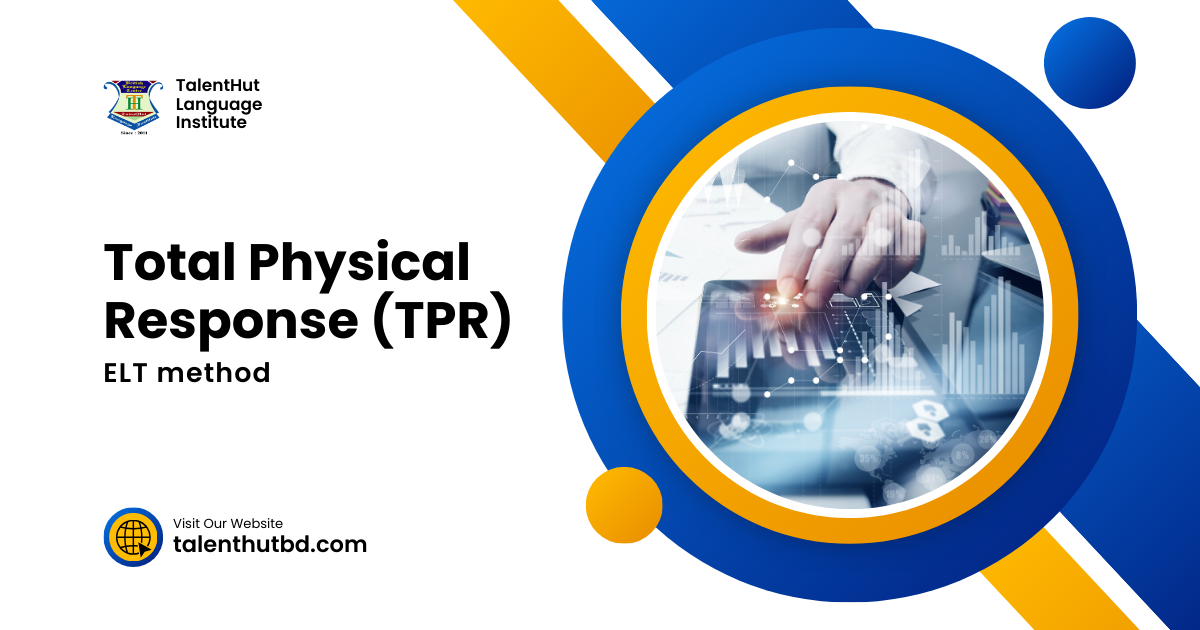TPR (Total Physical Response): A method to teach English
The Total Physical Response (TPR) Method to Teach English to ESL/EFL Students
The Total Physical Response (TPR) method is a dynamic and interactive approach to teaching English that leverages physical movement to facilitate language learning. Developed by Dr. James Asher in the 1960s, TPR is based on the idea that language comprehension is enhanced when learners physically respond to verbal instructions. This method is particularly effective for ESL/EFL students, as it integrates language with action, making learning both memorable and engaging. In this article, we will explore the principles of TPR, its practical applications, and how platforms like TalentHut can implement this method to enhance language acquisition, including preparation for exams like IELTS.
Understanding the Total Physical Response (TPR) Method
Overview: TPR is an instructional method where students respond to verbal commands with physical actions. It is grounded in the belief that language learning is more effective when it involves multiple senses, particularly the kinesthetic sense. TPR is especially beneficial for beginners and young learners, as it reduces stress and creates a fun, interactive learning environment.
Key Features:
– Emphasis on listening and physical response.
– Focus on understanding before speaking.
– Use of commands and actions to teach vocabulary and grammar.
– Low-stress, engaging, and enjoyable learning experience.
– Suitable for all age groups, particularly young learners.
Practical Applications of TPR
1. Teaching Vocabulary through Actions
Practical Application: At TalentHut, ESL/ELT classes can incorporate TPR by using physical actions to teach new vocabulary. For example, when teaching action verbs like “run,” “jump,” “sit,” or “stand,” the teacher can give commands while demonstrating the actions. Students then follow along by performing the actions as they hear the corresponding words. This helps solidify the connection between the word and its meaning, making it easier for students to recall and use the vocabulary in context.
2. Classroom Commands
Practical Application: TPR can be integrated into daily classroom routines at TalentHut. Teachers can use simple commands in English to manage classroom activities, such as “open your books,” “raise your hand,” or “sit down.” As students physically respond to these commands, they internalize the language associated with everyday actions. This approach is beneficial for beginners, providing immediate, contextualized language practice.
3. Storytelling with TPR
Practical Application: Storytelling can be made more engaging through the use of TPR. At TalentHut, teachers can tell a story and have students act out the events as they unfold. For example, while narrating a story about a day at the zoo, students can mimic the actions of animals like elephants stomping or monkeys swinging. This not only makes the story more memorable but also helps students learn new vocabulary and sentence structures in a fun, interactive way.
4. Role-Playing Activities
Practical Application: Role-playing is another effective way to use TPR in the classroom. TalentHut can organize role-playing scenarios where students act out situations like shopping, travelling, or dining at a restaurant. For example, in a role-play about ordering food, one student could play the role of a waiter while another plays the customer. The physical interaction—such as handing over a menu or pretending to eat—reinforces the language used in the conversation.
5. Integrating TPR with Technology
Practical Application: Technology can enhance TPR by providing interactive platforms for students to engage with language through movement. TalentHut can use educational apps and online games that combine physical actions with language learning. For instance, apps that require students to follow on-screen commands by performing actions can reinforce vocabulary and sentence structures. This approach is particularly effective for young learners who benefit from visual and physical engagement.
6. Using TPR for Grammar Instruction
Practical Application: TPR is not limited to vocabulary; it can also be used to teach grammar. TalentHut can design activities where students act out different grammatical structures. For example, to teach the present continuous tense, the teacher could say, “She is running,” and students would act out the verb “run.” This method helps students understand how grammar works in context and reinforces the structure through physical activity.
7. TPR in IELTS Preparation
Practical Application: While TPR is often associated with beginners, it can also be adapted for advanced learners preparing for exams like IELTS. TalentHut can incorporate TPR into IELTS speaking practice by having students physically respond to questions during mock interviews. For example, if asked about a hobby, students could demonstrate the activity (such as mimicking playing a musical instrument) while describing it. This approach helps reduce anxiety and encourages more natural, fluent responses.
Conclusion
The Total Physical Response (TPR) method offers a unique and effective approach to teaching English, particularly for ESL/EFL students. By combining language with physical movement, TPR makes learning more engaging, memorable, and enjoyable. TalentHut can effectively integrate TPR into its ESL/ELT programs, providing students with a dynamic and interactive learning experience that caters to different learning styles. Whether for building foundational vocabulary or enhancing speaking fluency for exams like IELTS, TPR equips students with the skills and confidence they need to succeed in their language learning journey.
Read our blogs:
Contact us:

